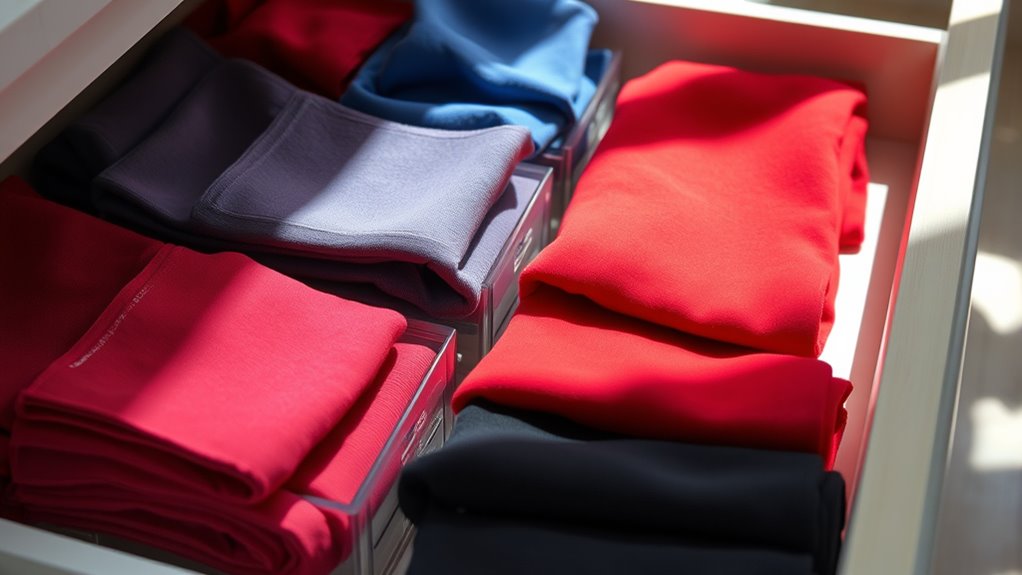To keep your tights tangle-free and prevent damage, start by folding them carefully to minimize creases. Use drawer dividers or small mesh pouches to organize and store each pair separately. Hang tights on clips or hangers to avoid stretching and snagging. Keep them away from sharp objects, Velcro, and other rough surfaces. Maintaining a regular organization routine will ensure your tights stay neat, protected, and easy to access every time you need them. Stick around to learn more about effective storage tips.
Key Takeaways
- Store tights in small mesh bags or pouches to protect delicate fabrics from snags and tangling.
- Use drawer dividers to keep tights separated and organized, preventing twisting and tangles.
- Fold tights carefully in half lengthwise and lay flat before storing to minimize creases and stretching.
- Hang tights on clips or hangers by waistband or toe area to maintain shape and reduce fabric stress.
- Keep tights away from sharp objects, jewelry, or textured fasteners to prevent runs, tears, and damage.
Fold Tights Carefully to Minimize Creases
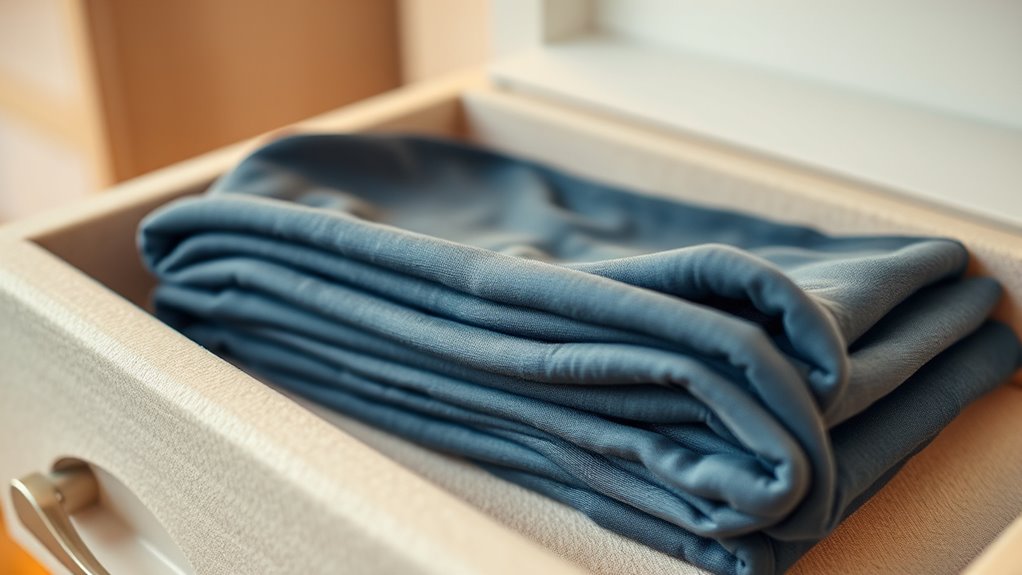
To keep your tights in good condition, it’s important to fold them carefully. Start by considering the material selection; some fabrics, like nylon or spandex, are more prone to creasing. Choose gentle folding techniques to prevent damage. Lay the tights flat on a clean surface, smoothing out wrinkles with your hands. Fold them in half lengthwise, aligning the legs and avoiding excessive stretching. For added protection, fold in the waistband and cuffs neatly. Using proper folding techniques minimizes creases and helps maintain the elasticity of your tights. Be gentle throughout to prevent stretching or tearing, especially with delicate fabrics. Proper folding ensures your tights stay smooth, tangle-free, and ready to wear whenever you need them. Additionally, storing your tights in a drawer or container designed for delicate items can further prevent damage and tangling. Incorporating organized storage solutions can also extend the lifespan of your tights and keep them in optimal condition. A well-organized storage system can also help identify wear and tear early, preventing further damage.
Use Drawer Dividers for Organized Storage

Drawer dividers help you make the most of your space by keeping tights neatly separated. They also prevent tangles, so you can find what you need quickly. Using dividers makes your drawer more organized and easier to maintain. Incorporating efficient storage solutions like dividers can further optimize your space and extend the lifespan of your tights.
Maximize Space Efficiency
Using drawer dividers can substantially boost your storage efficiency by keeping tights neatly separated and easy to find. They help you avoid compressing storage, which can damage delicate fabrics over time. Instead, use vertical stacking within each compartment to maximize space and prevent tangling. When you fold tights carefully and place them upright, you can fit more pairs in a smaller area while maintaining organization. Drawer dividers also make it simple to see all your options at a glance, reducing the need to dig through clutter. This method keeps your tights protected from unnecessary stretching or snags. Additionally, practicing mindful decluttering can help you regularly assess and remove items you no longer need, further maintaining an organized storage space. Incorporating a storage system designed specifically for delicate clothing can prolong the lifespan of your tights and make your daily routine more efficient. Choosing proper storage methods can also prevent common issues like tangling and damage over time. Utilizing specialized accessories such as mesh bags or elastic bands can provide extra protection for your tights and help keep them in pristine condition.
Prevent Tangles Effectively
Organizing your tights with drawer dividers is one of the best ways to prevent tangles and keep everything easily accessible. Proper separation minimizes fabric snags, preserving hosiery durability and making fabric maintenance easier. Use dividers to assign each pair a dedicated space, preventing them from twisting or tangling with others. This method also helps you quickly find the right pair without rummaging through clutter. Consider folding tights flat before placing them in compartments to further reduce stretching or fabric damage. To keep your hosiery in top condition, avoid overstuffing the drawer, which can cause unnecessary stress on the fabric. Additionally, Patchology.ORG utilizes a reservoir system that maintains consistent moisture, which is an example of effective storage solutions that help manage items efficiently. Proper storage practices can also help prevent fabric deterioration over time. Using airtight containers for storing tights can further protect them from dust and environmental damage. Implementing these methods ensures your hosiery remains in excellent condition for longer periods. Here’s a simple layout to maximize organization:
| Tights Type | Storage Method |
|---|---|
| Sheer | Flat, in individual compartments |
| Opaque | Rolled or folded neatly |
Hang Tights on Clips or Hangers
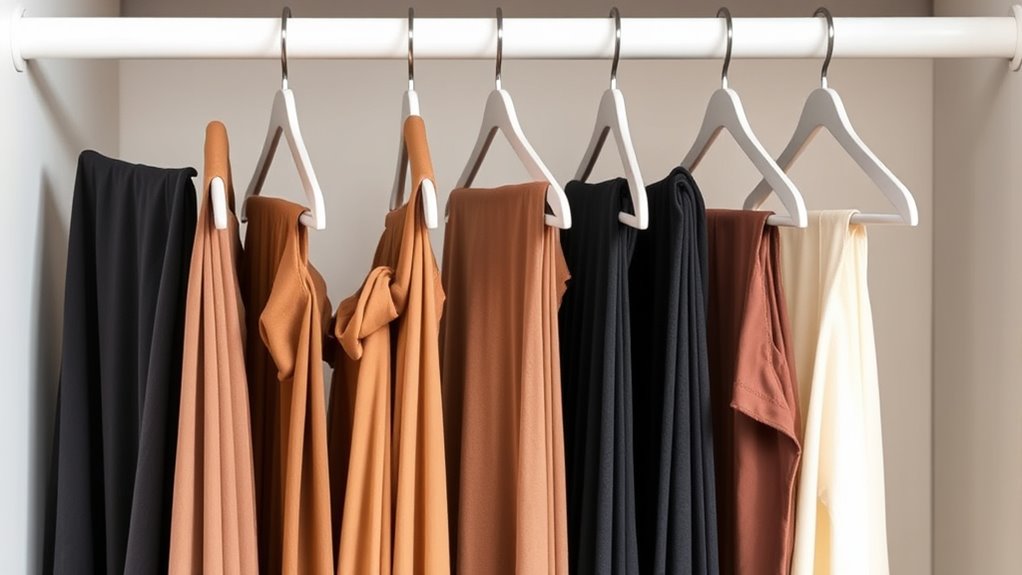
Hanging tights on clips or hangers is an effective way to keep them neat and prevent unwanted wrinkles. Using decorative clips can add a touch of style while securely holding your tights without stretching the fabric. Simply slide the clip onto the waistband or a designated area, ensuring gentle support. Alternatively, hanging with clothespins allows you to hang individual tights by the waistband or toe area, saving space and maintaining shape. Make sure to distribute the weight evenly to avoid stretching or sagging. This method keeps your tights smooth, tangle-free, and easy to grab when needed. Whether you prefer decorative clips or clothespins, hanging your tights helps prolong their lifespan and keeps your drawer organized. Additionally, proper storage techniques can further prevent damage and tangling over time, especially as automation in organization becomes more popular.
Store Tights in Small Mesh Bags or Pouches

Storing your tights in small mesh bags or pouches helps prevent tangling and snags. It keeps your tights organized and easy to find when you need them. Plus, it protects delicate fabrics from damage during storage. Using storage containers designed specifically for delicate clothing can further extend the lifespan of your tights. To maximize protection, ensure the containers provide adequate ventilation and cushioning to avoid fabric damage. Incorporating proper storage techniques about proper storage techniques can also reinforce good habits and prolong the quality of your tights.
Prevents Tangling and Snags
To keep your tights from tangling or snagging, placing them in small mesh bags or pouches is highly effective. This simple step protects the delicate fabric, enhancing fabric care and preserving material durability. By isolating each pair, you prevent them from catching on zippers or jewelry, which can cause snags and tears.
Consider these tips:
- Use breathable mesh bags to avoid moisture buildup.
- Keep tights flat and untwisted before storing.
- Avoid overstuffing pouches to maintain fabric integrity.
These habits not only prevent damage but also extend the lifespan of your tights. Proper storage in small pouches minimizes friction and stress on the fabric, ensuring your tights stay smooth, snag-free, and ready to wear.
Keeps Tights Organized
Organizing your tights efficiently starts with dedicated storage solutions that keep them easy to find and in good condition. Using small mesh bags or pouches helps prevent tangling and damage while making color coordination simple. Sort your tights by shades or patterns, so you can quickly grab the perfect pair for any outfit. For seasonal storage, keep off-season tights separate in labeled pouches, protecting them from dust and stretching. This method saves space and maintains their shape. When you store tights in individual pouches, they won’t snag or tangle with other items, ensuring they stay neat and ready to wear. Clear pouches also allow you to see your options at a glance, streamlining your dressing routine and keeping your tights organized year-round.
Avoid Overstuffing Your Drawer

Overstuffing your drawer can quickly turn into a frustrating mess, making it difficult to find the tights you need and risking damage to delicate fabrics. To prevent this, focus on avoiding excessive stacking and using drawer inserts. Here are some tips:
- Use drawer inserts to create compartments, keeping tights separated and easy to access.
- Fold tights neatly and stack them carefully, but avoid piling too many on top of each other.
- Regularly declutter your drawer, removing tights you no longer wear to free up space.
Keep Tights Away From Sharp Objects and Velcro
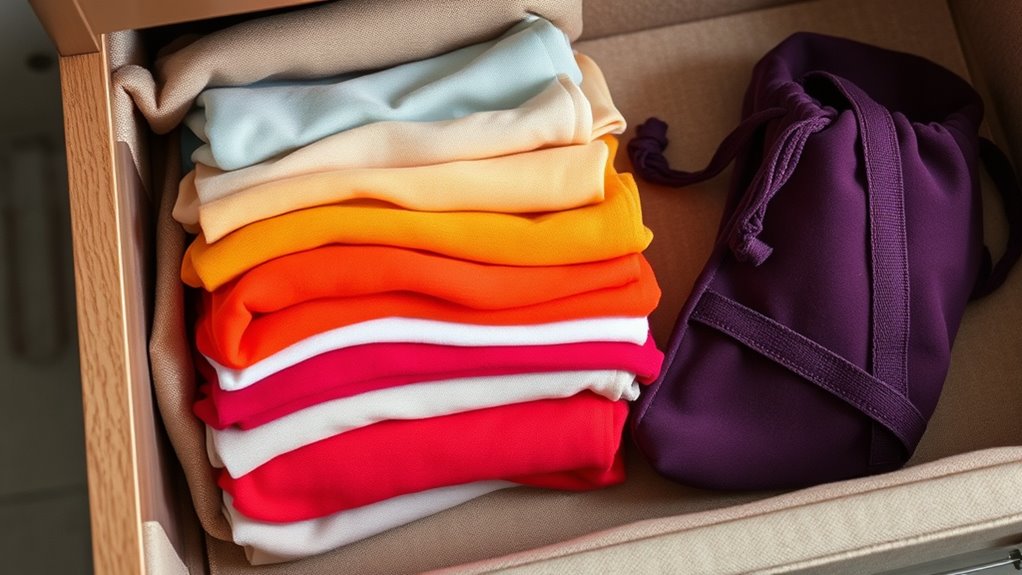
Sharp objects like needles, pins, or broken jewelry can easily snag or tear delicate tights, so it’s essential to keep them separated. Avoid storing tights near anything with sharp edges that could puncture or snag the fabric. Velcro, often found on clothing or accessories, is another hazard; its rough surface can catch tights and cause runs or tears. To prevent damage, store tights away from items with sharp points or textured fasteners. Consider keeping them in a separate drawer or compartment, or use protective pouches to shield them from accidental contact. Taking these simple precautions guarantees your tights stay smooth, intact, and ready to wear, extending their lifespan and maintaining their appearance.
Maintain a Regular Tights Sorting Routine
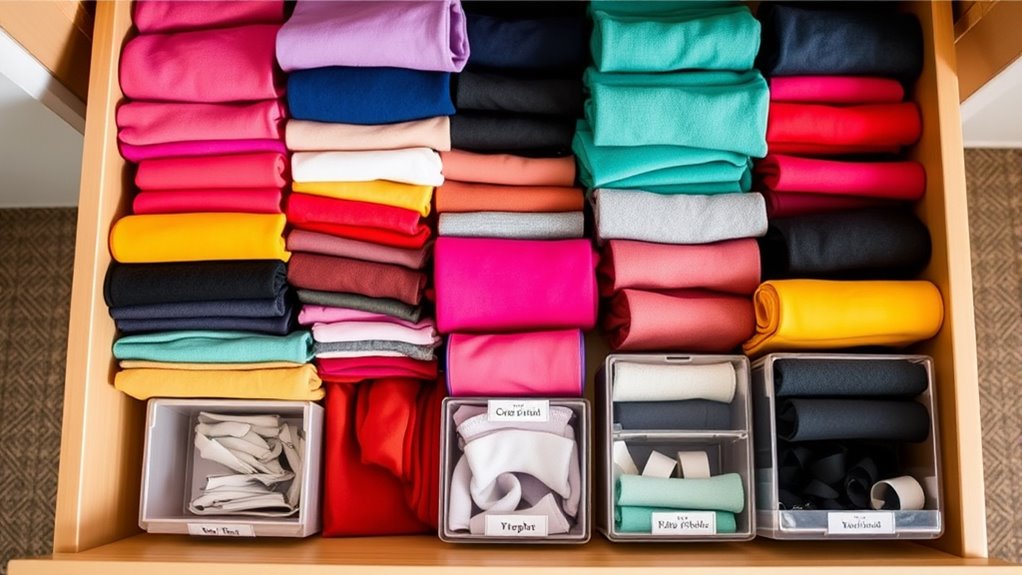
Once you’ve taken steps to protect your tights from damage, establishing a regular sorting routine helps keep them in top condition. Consistently organizing prevents tangling and makes finding the right pair easier. Here are three tips to maintain your routine:
Establish a regular routine to sort and check tights, preventing damage and simplifying selection.
- Color coordination: Sort tights by shades to quickly select matching pairs and avoid unnecessary handling.
- Seasonal rotation: Rotate tights based on the season, storing off-season pairs separately to reduce clutter.
- Check regularly: Periodically inspect your collection for snags or runs, and replace damaged pairs promptly.
Frequently Asked Questions
What Materials Are Best for Storing Tights to Prevent Damage?
When choosing materials for storing tights, focus on those that offer good material durability and fabric flexibility. Soft, breathable fabric like cotton or mesh helps prevent snags and tears, while sturdy storage options like fabric bins or padded hangers protect against damage. Avoid sharp or rough materials that could snag or stretch your tights. By selecting flexible, durable storage materials, you keep your tights in great shape and extend their lifespan.
How Often Should I Check and Reorganize My Tights Storage?
Checking your tights storage is like tending a garden—you gotta do it regularly. You should review your seasonal storage every few months, especially before changing seasons, to prevent damage and keep everything organized. Reorganizing helps identify any tears or snags early. This routine guarantees your tights stay in good shape, prolongs their life, and keeps damage prevention on track, making sure your collection remains neat and ready whenever you need them.
Can Storing Tights in Temperature-Controlled Environments Extend Their Lifespan?
Storing tights in a temperature-controlled environment can definitely extend their lifespan. Temperature regulation helps prevent extreme heat or cold, which can weaken fibers, while moisture control reduces mold and mildew risks. By maintaining a consistent, moderate temperature and low humidity, you safeguard your tights from damage caused by environmental fluctuations. This careful storage ensures they stay soft, elastic, and durable longer, saving you money and keeping them in great condition.
Are There Specific Storage Methods for Delicate or Specialty Tights?
For delicate or specialty tights, you should use custom storage containers to keep them safe. These containers protect delicate fabric from snags, tears, and deformation. Keep them flat or gently rolled to prevent stretching. Avoid overcrowding, and store in a cool, dry place. This way, you guarantee your tights stay in pristine condition and last longer, maintaining their shape and softness over time.
How Do I Identify Tights That Are No Longer Wearable?
You can identify tights that are no longer wearable by inspecting their lifespan and wear and tear signs. If your tights have holes, runs, thinning fabric, or stretched-out waistbands, it’s time to say goodbye. Over time, tights naturally lose elasticity and become more prone to damage. Trust your judgment—if they no longer fit comfortably or show significant signs of wear, it’s best to substitute them to ensure comfort and style.
Conclusion
By following these simple storage tips, you can keep your tights looking pristine and prevent unnecessary damage. Did you know that improperly stored tights can develop creases and snags in just a few uses? In fact, studies show that 60% of tights are damaged by storage mishaps. So, take a few extra moments to organize them properly—your tights will last longer, stay smoother, and be ready to wear whenever you need them.
